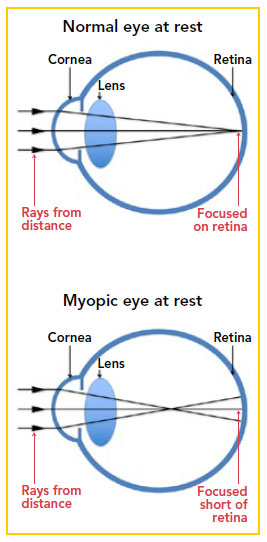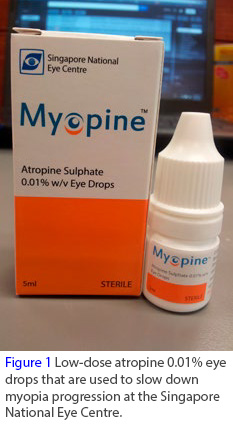Childhood myopia, otherwise known as short-sightedness or near-sightedness, is the condition of the eye when distance vision is more blurred compared with near vision. It tends to increase rapidly between 5 and 15 years old, and usually stabilises by the early twenties. In Singapore, 10% of kindergarten children, 60% of primary 6 students, and 80% of 18-year-olds are myopic.
WHAT CAUSES MYOPIA?
 Myopia arises from the excessive growth with elongation of the eyeball. This results in light rays from distant objects focusing in front of the retina instead of on the retina. Distant objects are thus seen to be blurred but near objects remain clear.
Myopia arises from the excessive growth with elongation of the eyeball. This results in light rays from distant objects focusing in front of the retina instead of on the retina. Distant objects are thus seen to be blurred but near objects remain clear.
MYOPIA: RISK FACTORS AND COMPLICATIONS
The exact cause of myopia is not known, but certain risk factors increase the likelihood of myopia, such as:
-
Genetics. The risk of developing myopia is higher if one (2 times more) or both (8 times more) parents are myopic. In addition, increasing severity of parental myopia leads to a greater risk of myopia.
1,2
-
Environmental. Lack of outdoor activities and excessive near work like reading, playing games on handheld electronic devices or computers, and watching television expose one to the risk of developing myopia.3
Other than the inconvenience of having to wear spectacles, myopia may be associated with complications such as:
-
Retinal tears and detachment. The eye with high myopia is excessively elongated, resulting in thinner retina. This puts the eye at greater risk of developing a retinal tear, hole or detachment. Retinal detachment requires urgent treatment, as unless the detached retina is promptly reattached, there can be permanent loss of vision in the affected eye
-
Macular degeneration. Severe myopia such as more than 10 dioptres (1,000 degrees) may be associated with macular degeneration. The macula is the central part of the retina that gives the clearest vision. Macular degeneration causes difficulties with reading, watching TV and recognising people’s faces.
-
Cataract. Myopia is associated with earlier onset of cataract, which is opacity or clouding of the lens that causes blurring of vision.
-
Glaucoma. Glaucoma is associated with increased fluid pressure within the eyeball. Severe myopia increases the risk of developing glaucoma, which left untreated over time can cause blindness. Glaucoma is often symptomless; causing poor vision gradually, and therefore called a ‘thief of sight’.
PREVENTION OF MYOPIA AND MYOPIC PROGRESSION
Spectacles, contact lenses and refractive surgery can help to bring distant objects into focus. However, they do not cure myopia, as the eye is still elongated, retaining the same risk of retinal detachment, macular degeneration, etc. Therefore, prevention of myopia and delaying its progression early in life are important steps in management of myopia.
Environmental modification
Children should be encouraged to adopt good eye care habits from a young age, even before they develop myopia. It is important to restrict time spent on near work and to take frequent ‘eye breaks’ by looking out into the far distance every 20 to 30 minutes. This breaks any accommodative (focusing for near) spasm and helps relax the eyes.4 Outdoor activities should be encouraged as natural daylight appears to be protective against myopia, and children who spend plenty of time outdoors are less likely to be myopic.3
Use of atropine eye drops
 There is currently no cure for myopia, but atropine eye drops have been prescribed for slowing down the progression of myopia in children since the 1960s. Higher-dose 1% atropine eye drops have been used to treat myopia at the Singapore National Eye Centre (SNEC) since the 1990s.
There is currently no cure for myopia, but atropine eye drops have been prescribed for slowing down the progression of myopia in children since the 1960s. Higher-dose 1% atropine eye drops have been used to treat myopia at the Singapore National Eye Centre (SNEC) since the 1990s.
Studies have shown that it slows myopia progression by 80% over a two-year period, but is also associated with uncomfortable side effects like glare and blurring of near vision due to dilation of the pupils and paralysis of the ciliary muscle of the eye.
As a result, children on 1% atropine eye drop treatment often require photochromatic or sunglasses with UV filter, and a progressive or reading add in their glasses. Other possible side effects are often mild and temporary e.g. dry eyes and eye allergy. The more severe systemic side effects of atropine like palpitations, confusion, dry mouth, high fever, etc are extremely rare.
More recently, low-dose 0.01% atropine eye drops have been shown to be effective in slowing down myopia by 50% to 60% over two years (Figure 1).5 The effect of low-dose atropine appears to build up over time, with more profound effects in the second year than the first.
At five years, it has been shown to be more effective in slowing down myopia progression with less visual side effects compared to the higher doses of atropine eye drops.6 As it causes minimal increase in pupil size, children do not require tinted or reading add in their glasses. They are also less likely to have the other side effects associated with the higher-dose atropine.
However, myopia progression may still occur in some children, and if rapid, they may then need to be converted to a higher dose of atropine. Unfortunately, in 10% of children, myopia may continue to progress rapidly even with the higher-dose atropine.
GPs can call for appointments through the GP Appointment Hotline at
6322 9399.
By: Deborah Tan, Associate Consultant, General Cataract and Comprehensive Ophthalmology Department, Singapore National Eye Centre
Dr Deborah Tan is currently an Associate Consultant at the Singapore National Eye
Centre (SNEC). She graduated from the Yong Loo Lin School of Medicine at the National
University of Singapore and completed her ophthalmology residency at SNEC.
She has been elected as a Fellow of the College of Surgeons of Edinburgh and Fellow
of Academy of Medicine of Singapore, and is currently undergoing fellowship
training in Paediatric Ophthalmology at SNEC.
References
1. Component dependent risk factors for ocular parameters in Singapore Chinese children. Ophthalmology. 2002;109:2065-2071
2. Ethnic differences in the impact of parental myopia: findings from a population-based study of 12-year-old Australian children. Invest Ophthalmol Vis Sci 2007;48:2520-2528
3. Outdoor activity reduces the prevalence of myopia in children. Ophthalmology. 2008 Aug;115(8):1279-85
4. Role of near work in myopia: findings in a sample of Australian school children. Invest Ophthalmol Vis Sci. 2008 Jul;49(7):2903-10
5. Atropine for the treatment of childhood myopia: safety and efficacy of 0.5%, 0.1%, and 0.01% doses (Atropine for the treatment of myopia 2). Ophthalmology 2012 Feb;119(2):347-54
6. Five-year clinical trial on atropine for the treatment of myopia 2: Myopia control with atropine 0.01% eyedrops. Ophthalmology 2016 Feb;123(2):391-9.
Tags:
Eye
;
;
Eye;
;
Publication;News Article;
Singapore National Eye Centre;
Singapore National Eye Centre;
Article;
SingHealth Medical News;Medical News;
;
;
Cataract & Comprehensive Ophthalmology Department;
;
Patient Care;Medical News (SingHealth);Medical News
